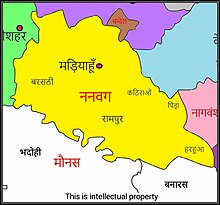The Nandwaks/Nanwag Rajputs are a branch of the Kachwaha Rajput in what is now the Indian state of Uttar Pradesh. In the 16th century, founder of nanwag dynasty shree Naun Rao ji and his descendants seized mariahun tahasil and ruled there for many years after.[1] The villages of Kathiraon, Newarhia (having fort of Nanwag chieftain, Zamindar Sangram Singh)[2] lying at 25" 31' N longitude and 82" 80' E latitude (tahsil Mariahu)[2] and Barsathi, latitude 25" 34' N and longitude 82" 91' E in Mariahu tehsil,[3] were administered by the Nanwag Rajputs from the 16th century to the later part of the 19th century.[4] The whole of Mariahu tehsil was administered by them during the medieval period and the tehsil got its name from Mandav Dev, the presiding deity of Nanwags.[5] currently they are spread in Prayagraj, Azamgarh, Mirzapur and Varanasi district. In census report of 1865,population of Nanwag rajput was approximate 24,000.


See also
[edit]References
[edit]- ^ Uttar Pradesh District Gazetteers: Varanasi. Uttar Pradesh: Government of Uttar Pradesh. 1965. p. 44.
- ^ a b Uttar Pradesh District Gazetteers: Jaunpur. Uttar Pradesh: Government of Uttar Pradesh. 1986. p. 295.
- ^ Uttar Pradesh District Gazetteers: Jaunpur. Uttar Pradesh: Government of Uttar Pradesh. 1986. p. 285.
- ^ Uttar Pradesh District Gazetteers: Varanasi. Uttar Pradesh: Government of Uttar Pradesh. 1965. p. 403.
- ^ Uttar Pradesh District Gazetteers: Jaunpur. Uttar Pradesh: Government of Uttar Pradesh. 1986. p. 293.
Well, that’s interesting to know that Psilotum nudum are known as whisk ferns. Psilotum nudum is the commoner species of the two. While the P. flaccidum is a rare species and is found in the tropical islands. Both the species are usually epiphytic in habit and grow upon tree ferns. These species may also be terrestrial and grow in humus or in the crevices of the rocks.
View the detailed Guide of Psilotum nudum: Detailed Study Of Psilotum Nudum (Whisk Fern), Classification, Anatomy, Reproduction